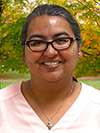What do teachers need to know about young English learners with disabilities?
Page 2: Distinguishing Between Disability and Language Difference
 Delays in social and communication development might occur when children are learning two or more languages. Because such delays can be red flags for further developmental problems in the areas of social-emotional development and cognition, early childhood educators must determine their cause: language difference or disability. Teachers attempting to distinguish between a disability and a language difference should begin by addressing a few key questions:
Delays in social and communication development might occur when children are learning two or more languages. Because such delays can be red flags for further developmental problems in the areas of social-emotional development and cognition, early childhood educators must determine their cause: language difference or disability. Teachers attempting to distinguish between a disability and a language difference should begin by addressing a few key questions:
social-emotional development
glossary
For Your Information
Head Start’s National Center on Cultural and Linguistic Responsiveness has developed a helpful resource that instructors can use—with assistance from a child’s family—to determine a child’s exposure to different languages. Click to download “Gathering and Using Language Information That Families Share.”
- Compared to English, for how long has the child been speaking and exposed to their home language? Keep in mind that it is typical for a child learning a second language to have a silent period.
- Are the difficulties present in both the child’s home language and the new language?
- Are the concerns evident in multiple settings (e.g., home, childcare)?
- Have developmentally appropriate strategies been delivered systematically?
- Have these strategies produced any significant differences in the child’s learning and development?
As they consider the answers to these questions, it is particularly important for teachers to keep in mind that a child’s developmental delay or disability will be observable in both languages and across multiple settings. Additionally, developmentally appropriate strategies will likely produce noticeable gains for typically developing ELs but not necessarily for those with disabilities. A bilingual speech/language pathologist (SLP) can also assist teachers and parents in distinguishing delays in children’s skills that may be caused by disability from what is in fact the typical language development for bilingual children and the second language acquisition process. If an instructor’s answers to the questions outlined above indicate that a language difference is not the cause of the delays, screening and possible evaluation for a disability is warranted.
Listen as Irlanda Jimenez further discusses some considerations for determining whether a child has a developmental delay or a language difference (time: 1:34).
Irlanda Jimenez
Multicultural Coordinator, Bilingual/ESL Teacher
Urbana Early Childhood Schools

Transcript: Irlanda Jimenez
Sometimes there is that concern about some type of developmental delay, whether it be language, whether it be cognitive, and so forth, trying to figure out is it developmental delay or is it learning English as a second language? One of the things I ask parents is, “Do you see this also in the native language?” For example, if I have a parent that says, “My child is only using one- or two-words sentences,” and let’s say the child’s home language is Arabic. So I will say, “Okay, is that example in English?” And if they say, “Oh, yes. it is.” “Okay, so tell me in Arabic, what does their language look like?” “Oh, no, in Arabic they’re saying sentences. They’re answering questions.” So I think that’s definitely one of the big things, is making sure that they’re seeing it in the home language as well.
Another thing is comparing the two languages and make sure that the kids aren’t using first language to sort of transfer to second language, if that makes sense. So, for example, in Spanish we might say “carro rojo” which is noun-adjective, when in English it’s “red car.” So if you have a child that is using that in trying to speak in English and then you may be like, oh, my gosh, they’re totally off. But once you get a chance to study the language you can see they’re transferring skills from one to the other inappropriately.
For Your Information
Grammatical and structural differences among languages are frequently the source of apparent language errors among ELs. For example, in Tagalog there are no gender specific pronouns (i.e., he, she, him, her). It is common for Tagalog speakers to misuse these pronouns when speaking in English. In many cases, these errors can be corrected through extended exposure to English and specific instruction and should not be automatically interpreted as signs of a disability.
Screening and Evaluation

The first step in determining whether a child has a developmental delay or disability is to collect more information through processes such as:
- Screening is a simple process to assess a child’s health or to determine whether the child is meeting developmental milestones. For example, pediatricians conduct developmental screenings during well-baby checkups to diagnose vision or hearing concerns or to identify children who are not meeting developmental milestones. In addition, some screenings are conducted by early childhood educators or other professionals such as a vision specialist or a speech/language pathologists.
- Evaluation is a more formal process involving multiple assessments to collect more in-depth information on specific developmental areas and skills. Evaluations are conducted by a multi-disciplinary team of qualified professionals (e.g., early intervention specialist, speech/language pathologists, physical therapists).
For Your Information
All states have a system to identify young children with developmental delays or disabilities, referred to as child find. Through this system, anyone (e.g., teacher, parent) can refer a child who they suspect of having a disability.
Child Find
glossary
The results of this evaluation help the multidisciplinary team determine whether the child qualifies for special education services which, for young children from birth to age three, are known as early intervention services. For preschoolers, these services are provided through preschool or early childhood special education and related services. The determination of eligibility for early childhood special education services must not rest on one test score but rather a combination of results based on but not limited to, standardized and performance-based measures, multiple observations of the child across settings and routines, and input from family members, professionals, and other adults who interact routinely with the child. This process applies to any young child; however, for ELs, the results of the evaluation must clearly demonstrate a disability or delay in all of the child’s languages.
multidisciplinary team
glossary
Listen as Robert Stechuk highlights three sources of data that can inform the assessment process for young ELs (time: 3:39).

Robert Stechuk, PhD
Transcript: Robert Stechuk, PhD
Assessment is a key component of quality services. For programs who are serving young dual language learners, if it’s assessing children for instructional purposes, trying to figure out how and what to teach, or if it’s assessment to identify and establish the presence of a disability, there are essentially three main sources of data to look at. Number one is data from families. If the program has the capacity to speak with families in their home language or get a translator, using information from families—whether it’s a combination of checklists, or parent narratives, or parent reports, or asking families to talk about their child’s development—families can be a rich source of data for informing programs about the nature and course of children’s development across all developmental domains and across both of their languages.
The second data source would be observations of child in the classroom. The child may not speak any English. The child may grow up speaking Arabic or Vietnamese or Korean. They may have had no prior experience with English. The value of observations is that, because the focus is on the child’s behaviors, that’s really where we want the data to come from. The assessment strategy would be to welcome the child into the classroom, to communicate using a variety of communication methods that further invite the child to look around the classroom, and to become engaged in one or more activities. Offering children choices is a natural way of getting the children engaged in activities that they’re interested in. So the child may come into the classroom having no prior experience with English, but the teacher using gestures and smiles and by demonstrating can say, “Here’s the sand table. Would you like to play here? Here’s the art area. Would you like to paint at the easel?” And then once children are engaged in the activity then the program staff can begin observing the child and recording examples of what does the child know and able to do. That data is also a very rich source for the assessment process.
The third area of data is the use of standardized tests. And that becomes tricky because, if the test was not developed using children from the child’s language background, that would tend to negate the validity of the standardized test results. Right now there are a number of standardized tests in English that have been shown to be reliable. There are a number of—not as many—instruments in Spanish that have been developed for the birth-to-five period. But for children coming from other language backgrounds, there are no standardized instruments that I know of. For children whose language background is not English or Spanish, my recommendation would be to utilize as much of the first two data sources as possible.
To learn more about screening or evaluating young ELs to determine whether a disability or a language difference exists, we encourage you to listen to the following IRIS Interview:
DEC Recommended Practices
The Division for Early Childhood (DEC) of the Council for Exceptional Children (CEC) provides guidance on recommended practices for young children with or at-risk for disabilities. The assessment strategies identified in the DEC Recommended Practices (DEC-RP) apply to all young children, including ELs. Additionally, a number of strategies apply specifically to young ELs. In the table below, the 11 DEC Recommended Practices on Assessment are matched to five strategies designed to address issues common to ELs. An example from Mrs. Raymond’s classroom is provided to illustrate how each strategy and the corresponding DEC Recommended Practices on Assessment might be implemented.
DEC Recommended Practice
- A1. Practitioners work with the family to identify family preferences for assessment processes.
- A2. Practitioners work as a team with the family and other professionals to gather assessment information.
- A7. Practitioners obtain information about the child’s skills in daily activities, routines, and environments such as home, center, and community.
A look inside Mrs. Raymond's classroom
At the beginning of the year, Mrs. Raymond shares information about her school’s screening and assessment process with families of the children in her preschool classroom. Mrs. Raymond’s school provides this information in multiple formats (e.g., print, online, audio) as well as in the families’ home languages.
A look inside Mrs. Raymond's classroom
Ideally, the school would use equivalent versions of screenings and assessments in different languages. For example, for her Spanish-speaking students Mrs. Raymond uses a Spanish version of the assessments and conducts the assessment in Spanish. However, because she does not have valid assessments in Burmese, she enlists the assistance of Ms. Aung, a trained interpreter fluent in both English and Burmese and who is also knowledgeable about special education and the assessment process.
DEC Recommended Practices
- A5. Practitioners conduct assessments in the child’s dominant language and in additional languages if the child is learning more than one language.
A look inside Mrs. Raymond's classroom
In Mrs. Raymond’s class there are several children who have been only minimally or sporadically exposed to their home language. According to their parents, these children only speak English in the home. Mrs. Raymond conducts their screenings and assessments in English. Other children have equal exposure to Spanish and English. Because many of these children have skills that are distributed across both languages, Ms. Mansilla and Mrs. Raymond conduct their screenings and assessments in both Spanish and English.
DEC Recommended Practices
- A3. Practitioners use assessment materials and strategies that are appropriate for the child’s age and level of development and accommodate the child’s sensory, physical, communication, cultural, linguistic, social, and emotional characteristics.
- A4. Practitioners conduct assessments that include all areas of development and behavior to learn about the child’s strengths, needs, preferences, and interests.
- A6. Practitioners use a variety of methods, including observation and interviews, to gather assessment information from multiple sources, including the child’s family and other significant individuals in the child’s life.
- A10. Practitioners use assessment tools with sufficient sensitivity to detect child progress, especially for the child with significant support needs.
- A9. Practitioners implement systematic ongoing assessment to identify learning targets, plan activities, and monitor the child’s progress to revise instruction as needed.
A look inside Mrs. Raymond's classroom
Russell Early Childhood Center has selected two different screening tools, primarily because of the reliability and validity of each tool based on the majority of the children represented in the school. In addition to the English version of the tool, a Spanish version is also available. Both screening tools include images that are relevant and familiar to the children’s experiences.
reliability
glossary
validity
glossary
The staff at Russell also developed an interview form in multiple languages that teachers can use to systematically gather information from families about their children’s skills and behaviors outside of the school setting. The staff and bilingual interpreters and translators use this information to inform the screening and assessment process.
DEC Recommended Practices
- A8. Practitioners use clinical reasoning in addition to assessment results to identify the child’s current levels of functioning and to determine the child’s eligibility and plan for instruction.
- A11. Practitioners report assessment results so that they are understandable and useful to families.
A look inside Mrs. Raymond's classroom
Mrs. Raymond and the school team review all of the information they’ve collected. Together, they look for patterns in the children’s performance across the screenings and assessments, parent interviews, and observations. The team prepares family friendly reports and, as often as possible, shares them with family members in their native language whenever possible.
Note: According to DEC, “In early intervention and early childhood special education, assessment is conducted for the purposes of screening, determining eligibility for services, individualized planning, monitoring child progress, and measuring child outcomes.” (DEC Recommended Practices, 2014)
Listen as Rosa Milagros Santos talks about how the DEC Recommended Practices can support young children’s development, including young EL children with disabilities (time: 1:36).
Rosa Milagros Santos, PhD
Professor, Special Education
University of Illinois at Urbana-Champaign

Transcript: Rosa Milagros Santos, PhD
DEC, the Division for Early Childhood of the Council of Exceptional Children, have developed a set of recommendations of different practices that they believe are supportive of young children’s development. Over the years, these practices have been used in many programs and classrooms and homes. The idea behind them is that these practices could produce strong positive outcomes for young children and their families. We’ve refined these recommended practices through the years to make sure that there is indeed a strong evidence-based support for these specific practices. The 2014 version of these recommended practices give us the most up-to-date, high-leverage practices, meaning that these are easy to implement but produce immediate positive outcomes for young children and their families.
In the 2014 iteration of the DEC recommended practices, there are certain practices specific to dual language learners that we found from the literature that have been effective when implemented with young children with disabilities. But it doesn’t mean that all the other practices are not effective for young children who are dual language learners. If you look at some of those practices, they’re broad enough that they could be used and implemented with young children. When you look at family practices, for example, or interaction or instruction, those are good practices that should be implemented across a range of young children without disabilities.
When working with ELs, especially those with disabilities, it is important for teachers to understand some unique issues around:
- Maintaining the home language
- Collaborating with families
- Using effective instructional strategies